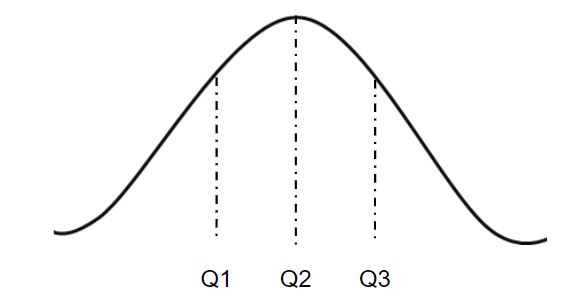numpy.nanquantile() in Python (original) (raw)
Last Updated : 02 Feb, 2023
numpy.nanquantile(arr, q, axis = None) : Compute the qth quantile of the given data (array elements) along the specified axis, ignoring the nan values. Quantiles plays a very important role in statistics.
In the figure given above, Q2 is the median and Q3 – Q1 represents the Interquartile Range of the given dataset.
Parameters : arr : [array_like]input array. q : quantile value. axis : [int or tuples of int]axis along which we want to calculate the quantile value. Otherwise, it will consider arr to be flattened(works on all the axis). axis = 0 means along the column and axis = 1 means working along the row. out : [ndarray, optional]Different array in which we want to place the result. The array must have same dimensions as expected output. Results : qth quantile of the array (a scalar value if axis is none) or array with quantile values along specified axis, ignoring nan values.
Code #1 :
Python3
import numpy as np
arr = [ 20 , 2 , 7 , np.nan, 34 ]
print ( "arr : " , arr)
print ( "\n-Q1 quantile of arr : " , np.quantile(arr, . 50 ))
print ( "Q2 - quantile of arr : " , np.quantile(arr, . 25 ))
print ( "Q3 - quantile of arr : " , np.quantile(arr, . 75 ))
print ( "\nQ1 - nanquantile of arr : " , np.nanquantile(arr, . 50 ))
print ( "Q2 - nanquantile of arr : " , np.nanquantile(arr, . 25 ))
print ( "Q3 - nanquantile of arr : " , np.nanquantile(arr, . 75 ))
Output :
arr : [20, 2, 7, nan, 34]
Q1 - quantile of arr : nan Q2 - quantile of arr : nan Q3 - quantile of arr : nan
Q1 - nanquantile of arr : 13.5 Q2 - nanquantile of arr : 5.75 Q3 - nanquantile of arr : 23.5
Code #2:
Python3
import numpy as np
arr = [[ 14 , np.nan, 12 , 33 , 44 ],
`` [ 15 , np.nan, 27 , 8 , 19 ],
`` [ 23 , 2 , np.nan, 1 , 4 , ]]
print ( "\narr : \n" , arr)
print ( "\nQ2 quantile of arr, axis = None : " , np.quantile(arr, . 50 ))
print ( "\nQ2 quantile of arr, axis = None : " , np.nanquantile(arr, . 50 ))
print ( "0th quantile of arr, axis = None : " , np.nanquantile(arr, 0 ))
Output:
arr : [[14, nan, 12, 33, 44], [15, nan, 27, 8, 19], [23, 2, nan, 1, 4]]
Q2 quantile of arr, axis = None : nan Q2 quantile of arr, axis = None : 14.5 0th quantile of arr, axis = None : 1.0
Code #3:
Python3
import numpy as np
arr = [[ 14 , np.nan, 12 , 33 , 44 ],
`` [ 15 , np.nan, 27 , 8 , 19 ],
`` [ 23 , 2 , np.nan, 1 , 4 , ]]
print ( "\narr : \n" , arr)
print ( "\nQ2 quantile of arr, axis = 0 : " , np.nanquantile(arr, . 50 , axis = 0 ))
print ( "0th quantile of arr, axis = 0 : " , np.nanquantile(arr, 0 , axis = 0 ))
print ( "\nQ2 quantile of arr, axis = 1 : " , np.nanquantile(arr, . 50 , axis = 1 ))
print ( "0th quantile of arr, axis = 1 : " , np.nanquantile(arr, 0 , axis = 1 ))
print ( "\nQ2 quantile of arr, axis = 1 : \n" ,
`` np.nanquantile(arr, . 50 , axis = 1 , keepdims = True ))
print ( "\n0th quantile of arr, axis = 1 : \n" ,
`` np.nanquantile(arr, 0 , axis = 1 , keepdims = True ))
Output:
arr : [[14, nan, 12, 33, 44], [15, nan, 27, 8, 19], [23, 2, nan, 1, 4]]
Q2 quantile of arr, axis = 0 : [15. 2. 19.5 8. 19. ] 0th quantile of arr, axis = 0 : [14. 2. 12. 1. 4.]
Q2 quantile of arr, axis = 1 : [23.5 17. 3. ] 0th quantile of arr, axis = 1 : [12. 8. 1.]
Q2 quantile of arr, axis = 1 : [[23.5] [17. ] [ 3. ]]
0th quantile of arr, axis = 1 : [[12.] [ 8.] [ 1.]]